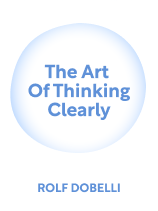

This article is an excerpt from the Shortform book guide to "The Art of Thinking Clearly" by Rolf Dobelli. Shortform has the world's best summaries and analyses of books you should be reading.
Like this article? Sign up for a free trial here .
What is the single cause fallacy? Why does it occur?
The single cause fallacy is where you attribute an outcome to a single, simple cause. The single cause fallacy occurs because we dislike uncertainty, and a single-cause pattern provides a sense of understanding. When people feel like they understand a situation, not only are they less uncertain, but they can also better withstand any uncertainty they do feel.
Keep reading to learn about the fallacy of the single cause, why it occurs, and how to overcome it.
The Fallacy of the Single Cause
The single cause fallacy or bias is where we oversimplify chains of events by making a simple pattern of cause and effect. We do this because humans are averse to uncertainty, including uncertainty over how events transpire. Looking for simple patterns reduces uncertainty because the fewer elements involved in a situation, the easier it is to understand the chain of events.
This mindset is dangerous because everything is affected by a complex web of influences and causes. There’s never a single cause for large, complex effects like crime or success. Trying to find one leads people to pin responsibility on a single person or group. Blaming a single person or group alleviates everyone else’s guilt without addressing systemic problems, which lets the problems continue unhindered.
Overcoming the Fallacy of the Single Cause
You can use the knowledge of this complex web of causes to your benefit, Dobelli says. When trying to determine how to make a project successful, don’t fixate on a single cause of success. Rather, examine all potential influences on your project. Focus on the factors you can influence, and experiment with how you can influence those factors. By experimenting with these factors, you can determine the most influential factors and use them to be more successful. For example, if you run a pizzeria, you can influence the quality of the food and staff you hire. By experimenting with these factors, you might learn that a skilled cook matters more than ingredients to customer satisfaction, so you focus more effort and money on hiring good cooks.
(Shortform note: These experiments are important even if you’re already experiencing success. People who experience success usually fail later because they attribute that success to their own actions without looking deeper. They don’t account for chance or evaluate the factors they influenced in gaining that success, which means they can’t replicate it. The only way to maintain success is to discern its cause and develop your ability to control said cause.)
| Occam’s Razor and the Single-Cause Fallacy While Dobelli cautions against oversimplifying a situation, others warn against overcomplicating it. For instance, Occam’s Razor states that when presented with two options, the simpler one is better. In this case, “simpler” means whichever option requires fewer assumptions. For example, consider these statements: “I have a headache because I didn’t drink water” and “I have a headache because I have a deadly disease.” The former requires two assumptions: You didn’t drink water and not drinking water causes headaches. The latter requires three assumptions: You have a disease, the disease is deadly, and the disease causes headaches. The first statement is simpler and therefore better. Doesn’t this contradict Dobelli’s point? If simple answers are better, isn’t simplifying logical? No, because there’s a difference between “better” and “accurate.” Simpler explanations are better, in that they are easier to understand, good for getting a basic understanding of complicated matters, and more probable. However, simpler explanations are not always accurate: Sometimes the complicated explanation is correct, if less likely. By this logic, ignoring information to create single-cause patterns trades accuracy for simplicity. As Dobelli says, this leads people to assign too much responsibility to an individual or group, but you also assign too much responsibility to single solutions. If you believe that high illness rates are due to unaffordable healthcare, you’ll work to make healthcare affordable. This singular focus means you won’t realize that you must address other factors like safe housing and income too. |

———End of Preview———
Like what you just read? Read the rest of the world's best book summary and analysis of Rolf Dobelli's "The Art of Thinking Clearly" at Shortform .
Here's what you'll find in our full The Art of Thinking Clearly summary :
- A detailed look at the most common logical fallacies that inhibit decision-making
- How to recognize and overcome these fallacies to make better decisions
- Why you value things for arbitrary reasons






